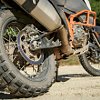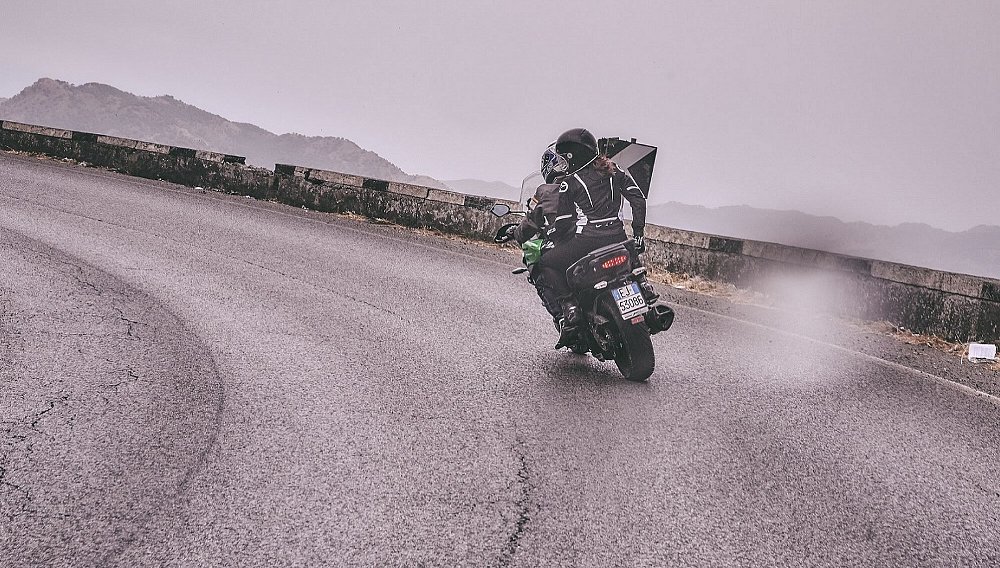What’s the difference between tubed and tubeless tires?
Uh, the tube. Even if you never saw a motorcycle before, you’d know that! But of course there’s actually more to it than that. The two kinds of motorcycle tires are constructed differently and have different advantages and applications.
Tubeless tires are designed to be airtight. Tube-type tires are made to work with a separate air-holding component that holds the pressurized air — the inner tube. So how did the system with two parts come before the simpler system with just one?

Tubed tires
Tubed tires were the first pneumatic motorcycle tires for several reasons. First of all, rubber’s properties vary wildly depending on how it’s manufactured and treated. The outside of a tire needs to be tough enough to endure miles of riding, while the tube needs to be soft and flexible so it can be installed inside the tire. By using two types of rubber to do two different jobs, we wound up with two components for much of motorcycling history.
Spoked (wire) wheels disappeared on cars a long time ago but they stuck around on motorcycles way longer, and are still with us today, in many applications. It's hard to make a traditional spoked wheel airtight, due to the holes for lacing spokes to the rim. One-piece wheels, on the other hand, could be made with a totally isolated chamber for holding air. The industry started turning out strong, precise, airtight wheels that made the tubeless revolution possible.

Tubeless tires
Tubeless tires offer some big advantages over their tubed counterparts. They reduce weight, run cooler, and can be made in a wide range of profiles. They can also handle punctures better. When a tubed tire takes a nail at 90 mph, the tube can deflate instantly, collapsing the tire with it. A tubeless tire can capture the nail (screw, or pointy road debris of your choice) in the tire’s thick main layer, sealing around the intruder to keep the air inside. Can being the important word here. It doesn’t always work out that way, but a tubeless tire gives you better odds of experiencing a slow deflation that gives you a chance to get off the road safely, instead of sudden and total deflation.
The other aspect of flat tires that matters here is repairing them. If you're standing alongside a busy highway with a nail in your tire, it's a lot easier to make a temporary repair on a tubeless tire. With a plug kit and a way to reinflate the tire, you can usually get back on your way. With a tube-type tire, you have to remove the wheel from the motorcycle so you can take the tube out of the tire, patch the hole (or replace the tube, if you're carrying a spare), then reassemble everything and reinflate the tire. It's still doable, but there are extra steps and you need a way to raise your motorcycle for wheel removal.
Why do we still have tube-type tires and spoked wheels?
Two reasons, mainly: off-road performance and looks.
Off-road machines are the biggest holdouts from tubeless tires. Spoked wheels offer real advantages in holding up to rough terrain, and where you have spokes you generally have inner tubes. Exceptions exist these days, however, especially on some larger, more expensive adventure-touring bikes. Some have wheels with the spokes attaching to the edge of the rim, rather than the center, or to a flange. This allows the wheel to be airtight and enables the use of tubeless tires, giving ADV riders the best of both worlds: the advantages of tubeless tires for high-speed road work and the resilience of spoked wheels for off-road pounding. Neat stuff.
The other place we typically see tube-type tires is on cruisers or other motorcycles with a retro style. For some riders who demand a traditional look, spokes just look right, and spokes mean tubes.

What is a valve stem?
The valve stem is an extension of the airtight chamber with a tiny valve inside for changing the pressure inside the tire. In a traditional inner tube setup, the valve stem is part of the tube itself. Poking through a hole in the rim, you’ll spot the stem and its lock nut holding it in place. When you replace your tube, the valve stem goes with it, and the new one replaces it.
Tubeless tires are the opposite. The valve stem is separate and mounts to the rim. (If you’ve got a pair of big disc brakes up front, consider adding a right-angle valve stem so you can more easily inflate your tires with the air hose at the gas station.) Tubes and valve stems should both be changed with every tire change. Heat cycling weakens rubber, weak rubber cracks, cracks leak, and flat tires are no fun, based on my testing.

Can you put a tube in a tubeless tire? Can you put a tubeless tire on a tubed wheel?
These are both things you can do, but that doesn't mean it will be easy, advisable or the best solution. If you want to run a particular type of tire on your motorcycle, the easiest way to do that is to pick a motorcycle that designed to do that in the first place. You may also be able to swap wheels, but that can be an expensive and complicated proposition.
If you insist on running a tube in a tubeless tire, the general rule of thumb is to treat the setup as one load rating and one speed rating less than the tubeless tire says it can handle. That's mainly because your tube and tire combination will be creating extra heat, especially the harder you ride.
As for a tubeless tire on a tubed wheel, we won't say it’s impossible, because someone will come along and say they did it successfully, but it's not easy and it's probably not the best way to accomplish whatever it is you're trying to do. You’d have to seal everything up with either some goo or a rubber liner to make the wheel airtight (it probably won't stay airtight). More importantly, the tubeless tire's bead will probably not seat properly and seal on the tube-type wheel's rim. They're not made for each other, after all. In short, it probably won't work and it may be unsafe to try.

If you’d like to learn more about motorcycle tires, make sure to read Lemmy’s Tires 101 guide and his tips on changing tires yourself. If you’ve never seen how tires are made, that’s worth checking out, as well. There’s probably a lot more to tires than you realize.

















